Abstract
Cucumber is an economically important vegetable crop, and the warts (composed of spines and Tubercules) of cucumber fruit are an important quality trait that influences its commercial value. WOX transcription factors are known to have pivotal roles in regulating various aspects of plant growth and development, but their studies in cucumber are limited. Here, genome-wide identification of cucumber WOX genes was performed using the pan-genome analysis of 12 cucumber varieties. Our findings revealed diverse CsWOX genes in different cucumber varieties, with variations observed in protein sequences and lengths, gene structure, and conserved protein domains, possibly resulting from the divergent evolution of CsWOX genes as they adapt to diverse cultivation and environmental conditions. Expression profiles of the CsWOX genes demonstrated that CsWOX9 was significantly expressed in unexpanded ovaries, especially in the epidermis. Additionally, analysis of the CsWOX9 promoter revealed two binding sites for the C2H2 zinc finger protein. We successfully executed a yeast one-hybrid assay (Y1H) and a dual-luciferase (LUC) transaction assay to demonstrate that CsWOX9 can be transcriptionally activated by the C2H2 zinc finger protein Tu, which is crucial for fruit Tubercule formation in cucumber. Overall, our results indicated that CsWOX9 is a key component of the molecular network that regulates wart formation in cucumber fruits, and provide further insight into the function of CsWOX genes in cucumber.
1. Introduction
The WUSCHEL-related homeobox (WOX) gene family belongs to the plant-specific subgroup of the homeodomain (HD) superfamily [1,2]. WOX genes have been identified in various plant species, such as Arabidopsis, apple, maize, rice, and soybean [1,3,4,5,6]. WOX transcription factors (TFs) possess a typical HD that contains 60–66 amino acids with a helix–loop–helix–Turn–helix structure [2,5,7]. Based on the type of HD and the presence or absence of the WUSCHEL (WUS)-box, WOX TFs can be classified into three phylogenetically distinct clades: the WUS clade, which contains a WUS-box and a representative motif FYWFQNH in the HD; the intermediate clade, which contains a representative motif FYWFQNR in the HD and lacks a WUS-box; and the ancient clade, which contains a representative motif YNWFQNR in the HD and also lacks a WUS-box [5,8].
WOX TFs play crucial roles in regulating various aspects of plant growth and development [9,10,11]. Many members of the WOX family are known to regulate stem cell formation and maintenance in seed plants. WUS is necessary for maintaining the homeostasis of the stem cell population in shoot apical meristems [12,13]. Similarly, WOX5, which is specifically expressed in the root apical meristems (RAMs) quiescent center, and WOX4 are also involved in stem cell maintenance [14,15,16]. In Medicago truncatula and pea (Pisum sativum), the WOX5 gene was expressed during nodule organogenesis and might control cell proliferation and differentiation in nodule meristems [17]. Additionally, WOXs are involved in plant development processes such as root, flower, and fruit development. For instance, rice OsWOX11 recruits the histone acetyltransferase complex ADA2-GCN5 to regulate crown root cell proliferation [18]. In Arabidopsis, AtWOX7 plays an important role in integrating nutrient status with the lateral root formation program [19]. In rice, OsWOX4 controls primary root elongation by influencing the size of root meristem as well as the cell length in the mature zone in the root tip via the auxin signaling pathway [20]. Furthermore, PtoWOX5a and PtoWUSa from poplar have been identified as critical regulators of root development [21,22]. Tomato UF, which encodes the SlWOX1 protein, is involved in controlling flower and leaf lateral growth [23]. Moreover, WOX genes such as OsWOX13 from rice, AtWOX13 and AtWOX14 from Arabidopsis, and EVERGREEN (EVG) from Petunia, are known to play important roles in flower development. Additionally, the PRETTY FEW SEEDS2 (PFS2/WOX6) gene is primarily expressed throughout developing ovules and regulates ovule development [24,25]. CsWOX9 is mainly expressed in developing fruit in cucumber, and its overexpression in Arabidopsis leads to shorter siliques [26].
Cucumber (Cucumis sativus L.) is one of the most economically important vegetable crops that produces edible tender fruits. The visual appearance of cucumber fruit is a crucial factor in determining its economic value. This includes characteristics such as peel color, fruit size, and the presence or absence of warts, which are composed of spines and Tubercules. Warts are a distinctive trait that sets cucumber apart from other fruits in the Cucurbitaceae family. Moreover, warts are also an important quality trait that impacts the market value of cucumber [27,28]. Consequently, studying the genes involved in wart formation is important for improving breeding to acquire desirable agronomic traits and enhance economic value of cucumber production. Given the WOX proteins play an important role in regulating plant growth and development, there is growing interest in identifying functional CsWOX genes that regulate wart formation. Based on the cucumber 9930 genome v2.0 or v3.0, 11 CsWOX genes have been identified, and some of these genes have shown organ-specific expression patterns [26,29].
Recently, there has seen a surge in the study of functional genomics, and the high degree of genomic variation observed, leading to the realization that a single reference genome does not reflect the diversity within a species [30,31,32,33]. Thus, the concept of the pan-genome, originally proposed in bacteria, has been expanded [34]. Pan-genomic analysis is now widely used in plant, fungal, and animal genomics to assess genetic diversity within species, as well as to explore cross-species gene exchange and domestication and improvement processes [31,32,33,34].
In cucumber, a graph-based pan-genome was constructed by analyzing 12 chromosome-scale genome assemblies [35]. Consequently, a new genome-wide identification of cucumber WOX genes was performed using the pan-genome of these 12 cucumber varieties. Comprehensive analyses, including of the protein sequences and lengths, gene structure, and conserved protein domains, were further performed. Additionally, the expression levels of CsWOX genes during cucumber fruit development were investigated. We found that CsWOX9 is mainly expressed in the epidermis of cucumber ovaries. Further studies revealed that the Tuberculate fruit gene Tu directly activates CsWOX9 by binding to its promoter.
2. Results
2.1. Identification of WOX Genes Based on Pan-genome of Cucumber
To investigate the potential function of the WOX genes in cucumber, we first identified the number of CsWOX genes in 12 different cucumber varieties. Consistent with previous studies [26,29], we identified 11 putative WOX genes in cucumber 9930 (genome v2.0 and v3.0) (Table 1). There were 10 CsWOX genes (not including CsWOX2) obtained and further confirmed in Cu2, Cuc37, Cuc64, Cuc80, W4, W8, Hx14, Hx117, Gy14, and 9910gt (Table 1). In cucumber variety XTMC, only nine CsWOX genes (excluding CsWOX2 and CsWOX13a) were identified (Table 1). This discrepancy might arise from distinct evolutionary selection processes within various cultivation environments. Additionally, a phylogenetic tree was constructed, showing that these CsWOX genes, including 131 CsWOX genes from 12 cucumber varieties and 15 AtWOX genes, were divided into 3 classes (Figure 1). This result is consistent with previous studies in Arabidopsis and cucumber [1,25,28].

Table 1.
Identification of WOX genes in different cucumber varieties.
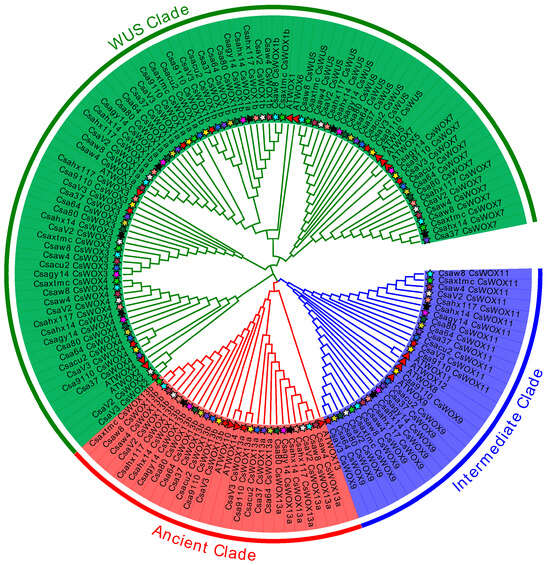
Figure 1.
The phylogenetic tree of 131 CsWOX proteins from 12 cucumber varieties and 15 AtWOX proteins, indicating that CsWOXs could be divided into 3 clades. The full lengths of all WOX proteins were used for phylogenetic analysis by MEGA7.0 software with the neighbor-joining (NJ) method. Three clades are represented by different colors. The star and triangle represent WOXs from cucumber and Arabidopsis, respectively. The stars with different colors represent different cucumber varieties.
In order to investigate whether the CsWOX genes differed among different cucumber varieties, the predicted lengths of CsWOX proteins were analyzed. As shown in Table 2, the CsWOX2 gene identified only in the cucumber variety 9930 was consistent in protein sequence and length in genome v2.0 and v3.0. However, other CsWOX genes displayed diversity in protein length across these 12 cucumber varieties. The longer length of CsWOX3 and CsWOX11 in W8, as well as CsWOX4 in Cuc64, compared to these CsWOXs in the other varieties, may be a result of termination codon delay or fragment insertion, whereas the shorter length of the CsWOX4 in W8, CsWOX7 in XTMC, CsWOX9 in 9910gt, and CsWOX13a in 9930 (genome v3.0) might be due to termination codon advancement or fragment deletions.

Table 2.
The predicted lengths of WOX proteins (amino acid residues) in different cucumber cultivars.
2.2. Gene Structure and Motif Composition of CsWOXs
Gene structural diversity can reflect the evolution of multigene families [36]. Therefore, we analyzed the exon-intron organization of the CsWOX genes, which vary in protein length in at least three different cucumber varieties. These include the ancient clade gene CsWOX13b, intermediate clade genes CsWOX9 and CsWOX11, and WUS clade genes CsWOX1a, CsWOX4, CsWOX7, and CsWUS. In the ancient and WUS clades, we observed that the CsWOXs had one to four exons, and most members in different cucumber lines shared the same or similar intron/exon arrangements (Figures S1 and S2). For example, CsWOX13b contained two introns in all cucumber lines, with the exception of the 9930 genome v3.0, which had only one intron (Figure S1). CsWOX7 had no introns in the cucumber lines XTMC and 9930 (genome v2.0), but other varieties contained one intron (Figure S2). As shown in Figure 2A, CsWOX9 of the intermediate clade had three introns in most cucumber varieties. The number of introns in CsWOX11 of the intermediate clade gene varied across the 12 different cucumber varieties, ranging from 2 to 8. Notably, all Indian cucumber lines, including Cuc64, W4, W8, Hx14, and Hx117, contained at least five introns.
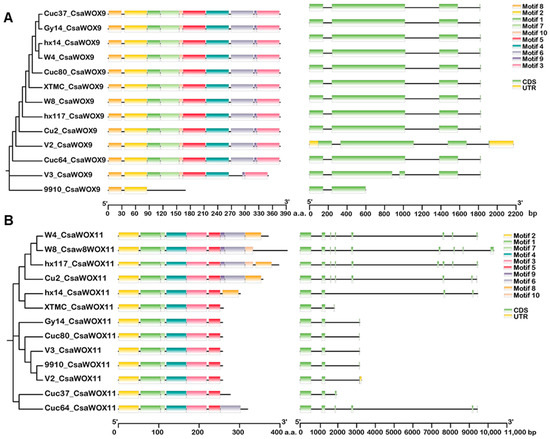
Figure 2.
Comparison of the conserved motifs and gene structures of intermediate clade genes CsWOX9 (A) and CsWOX11 (B) in 12 cucumber varieties. Left panel: the phylogenetic tree was constructed with the full length of WOX proteins using MEGA 7.0. Middle panel: the conserved motifs for CsWOX proteins. The motifs 1–10 are highlighted with different colors. Right panel: exon-intron structure of CsWOX genes. Black lines and light green boxes represent introns and exons, respectively. CDS, coding sequence; UTR, untranslated region; aa, amino acid; V2, cucumber 9930 genome v2.0; V3, cucumber 9930 genome v3.0; 9910, cucumber 9910gt.
To better understand the conservation and diversification of CsWOX genes across different varieties, the protein sequences of CsWOX genes, selected for structure analysis, were used for MEME motif analysis to identify conserved motifs. As expected, CsWOXs with similar or identical protein lengths exhibited comparable motif compositions (Figure 2, Figures S1 and S2). For instance, in the WUS clade gene CsWOX4, the protein length ranged from 226 to 228 amino acids (a.a.), and there were no differences in exon-intron organization and conserved motifs (Figure S1). Regarding the ancient clade gene CsWOX13b, the protein length in cucumber varieties Cuc37, Cuc80, W4, W8, Hx14, 9910gt, and Hx117 (encoding the protein length of 317 a.a.) increased compared to that in other varieties (encoding the protein length of 269 a.a.), while the gene structure remained unchanged. However, the number of conserved motifs increased. Motif 5 and motif 9 were found to be specific to CsWOX13b encoding the longer protein length of 317 a.a. (Figure S2). The protein length of the intermediate clade gene CsWOX9 was shorter in 9910gt and 9930 (genome v3.0). Furthermore, the gene structure underwent changes and some conserved motifs were absent (Figure 2). Notably, there were variations in protein length, gene structure, and conserved motifs of CsWOX7, CsWOX9, and CsWOX13b between the 9930 genome v2.0 and v3.0 (Figure 2, Figures S1 and S2), potentially due to the incomplete and low quality of genome v2.0.
2.3. Multiple Sequence Alignment of CsWOXs
In order to investigate whether there were differences in the sequence and conservation of the domain for the same CsWOX member in different cucumber lines, we selected the WUS clade member CsWOX4 and the intermediate clade member CsWOX9 as representatives for analysis. The alignment results showed that all members of CsWOX4 and CsWOX9 contained a conserved HD that carried a helix–loop–helix–Turn–helix structure, except for CsWOX9 in cucumber variety 9910gt (Figure 3A,B). We discovered that the representative motifs FYWFQNH and WUS-box were present in all members of CsWOX4 (Figure 3A). However, the intermediate clade gene CsWOX9 did not have a WUS-box, and the representative motif of HD also had a single amino acid substitution: H for R (FYWFQNR), except for CsWOX9 in the cucumber variety 9910gt, which had a deletion of fragments, resulting in an incomplete HD (Figure 3B). Furthermore, we found that the sequences of CsWOX4 and CsWOX9, which had the same or similar protein lengths in different cucumber varieties, were not identical (Figure 3A,B). These variations possibly stem from the divergent evolution of CsWOX genes as they adapt to diverse cultivation and environmental conditions.
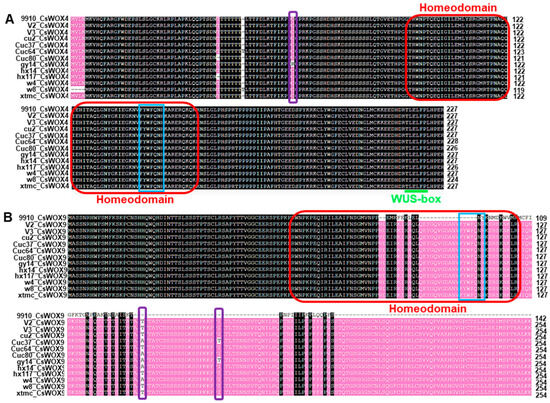
Figure 3.
Alignment of multiple amino acid sequences of CsWOX4 and CsWOX9 from 12 cucumber varieties. (A) The sequence alignment of CsWOX4. (B) The sequence alignment of CsWOX9. The red box indicates homeodomain and the blue box represents conserved motifs in homeodomain. The purple box indicates amino acid polymorphism. The WUS-box is shown by a green line.
2.4. Identification of Fruit-Specific Expressed Gene CsWOX9
In previous studies [26,29], the expression patterns of the 11 CsWOX genes were examined in the cucumber variety 9930. It was found that some CsWOXs showed preferential expression across all tissues and organs, while others displayed obvious organ-specific expression patterns [29]. Notably, CsWOX9 was mainly expressed in the developing ovaries of the cucumber [26]. Hence, we chose CsWOX genes from the cucumber variety 9930 (genome v3.0) as representatives for further study. Our findings revealed that out of the 11 detected CsWOXs, 5 were highly expressed in ovaries, namely CsWOX1a, CsWOX4, CsWOX9, CsWOX13a, and CsWOX13b. Among them, CsWOX9 exhibited considerably higher expression level compared to the other CsWOX genes in the unexpanded ovaries (Figure 4A). Moreover, CsWOX9 showed higher expression in the unexpanded ovaries than in the expanded fertilized ovaries and expanded unfertilized ovaries (Figure 4A), indicating that CsWOX9 may play crucial roles in the morphological changes of the unexpanded ovary. In order to investigate the role of the CsWOX9 gene in cucumber fruit, we examined its expression patterns in the epidermis and pulp using quantitative RT-PCR (qRT-PCR). The results indicated that CsWOX9 was mainly expressed in the epidermis (Figure 4B). Consistently, an in situ hybridization assay demonstrated strong expression of CsWOX9 in the epidermis of the cucumber ovaries (Figure 4C). Based on these findings, we hypothesize that CsWOX9 may regulate the formation of the fruit wart phenotype.
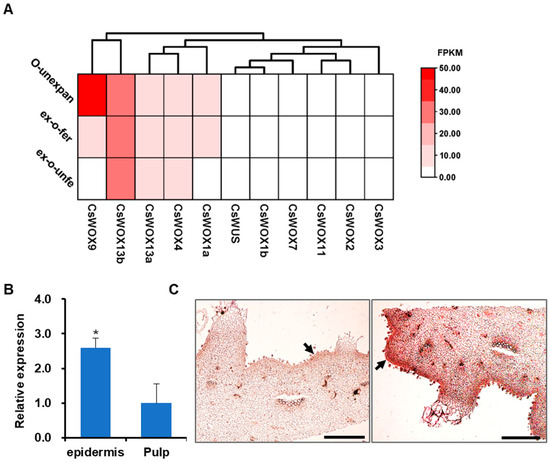
Figure 4.
Expression pattern of CsWOX genes in cucumber. (A) The transcriptional levels of CsWOX genes in different developmental stages were investigated based on a public transcriptome data. The FPKM value of each gene was used to make the heat map. The color scale shows the increasing expression levels from white to red. O-unexpan, unexpanded ovary; ex-o-fer, expanded fertilized ovary; ex-o-unfer, expanded unfertilized ovary. (B) qRT-PCR analysis of CsWOX9 expression in epidermis and pulp of the cucumber ovary at 7 DBA. The cucumber UBI gene was used as an internal standard. (*) indicates significant differences at p < 0.05 (Student’s t-test). (C) mRNA in situ hybridization of CsWOX9 in cucumber line 9930 ovaries at 7 DBA. Left, negative control using the sense probe. Right, strong signal was detected in the epidermis using antisense gene-specific probes. Black arrows indicate expression locations of CsWOX9 in fruit epidermis. DBA, days before anthesis; Scale bars: 500 μm.
2.5. Subcellular Localization of CsWOX9
The localization of the CsWOX9 was investigated using two methods. Firstly, an online search Cell-PLoc (cellular localization of proteins) suggested that CsWOX9 might be located in the nucleus. Secondly, a tobacco transformation system was used to study the subcellular localization of CsWOX9. The 35S::CsWOX9-GFP was constructed and introduced into tobacco leaves. Fluorescence microscopy results showed that the CsWOX9-GFP fusion protein and the nucleus marker NF-YA4-mCherry were co-localized in the nucleus (Figure 5A–D). As a control, the expression of 35S::GFP was observed throughout the epidermal cell (Figure 5E–G). Consistently, Tu, a regulator of fruit Tubercule formation, was also located on the nucleus [27].
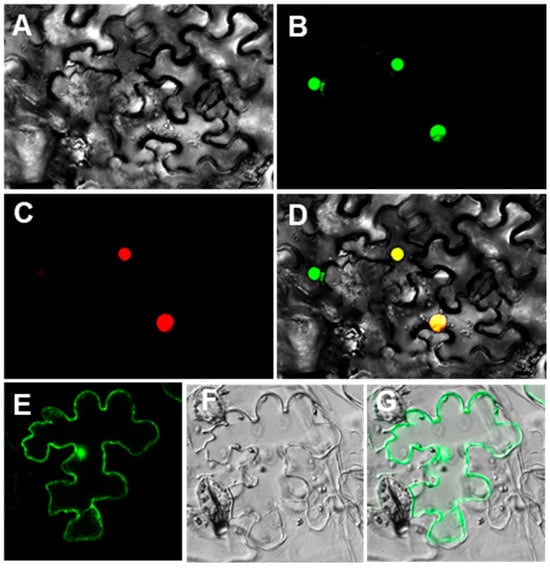
Figure 5.
Subcellular localization of CsWOX9 protein in tobacco epidermal cells. The 35S::CsWOX9-GFP and nucleus marker NF-YA4-mCherry are co-localized in the nucleus (A–D), while the signals of 35S::GFP are detected throughout the cell (E,F). (A,F) DIC image. (B) CsWOX9-GFP. (C) Nucleus marker NF-YA4-mCherry. (D) Merged image of (A–C). (E) GFP alone. (G) Merged image of (E,F).
2.6. Tuberculate Fruit Gene Tu Directly Activates CsWOX9 by Binding to Its Promoter
Cis-elements were analyzed in the promoter of CsWOX9. The results revealed the identification of two cis-elements (ACTCAAC and ACTCCAC) that were bound by the C2H2 zinc finger protein (Figure 6A). The Tu gene, which encodes a C2H2 zinc finger protein, is required for the formation of fruit Tubercules in cucumber. This finding indicated that Tu may regulate CsWOX9 transcriptionally by binding to its promoter. To test this hypothesis, two fragments, P1 and P2, containing the cis-elements ACTCAAC and ACTCCAC respectively, from the promoter of CsWOX9s were investigated using Y1H assays. As shown in Figure 6B, the Y187-carrying PGADT7 vectors and pHis2-P1 or -P2 vectors did not grow in the synthetic dextrose (SD) /-Trp/-Leu/-His medium supplemented with 50 or 100 mM 3-amino-1,2,4-triazole (3-AT), respectively. The clear positive results of the combination of AD-Tu and pHis2-P1 or -P2 indicated that Tu protein could bind to the protomer of CsWOX9. To further confirm this interaction, we performed a dual-luciferase reporter (DLR) assay in the leaves of tobacco (Nicotiana benthamiana). Compared to the vector control, the relative intensity of LUC signals significantly increased upon co-transformation of 35S::Tu with ProCsWOX9::LUC (Figure 6C), suggesting the activation of CsWOX9 expression by Tu. Thus, the Y1H and DLR assays substantiated that the Tu gene activated the gene CsWOX9 to regulate the formation of fruit Tubercules in cucumber.
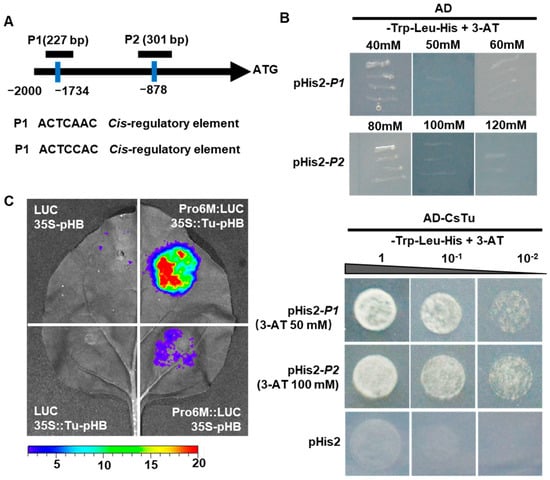
Figure 6.
Transcriptional activation of CsWOX9 by Tuberculate fruit gene Tu. (A) Schematic diagram of the promoter fragments of CsWOX9 containing the binding sits of Tu used for Y1H assay. (B) The interaction was examined in SD medium lacking Trp, Leu, and His and containing 50/100 mM 3-AT. The empty vector pHis2 was set up as a negative control. (C) DLR assay showed that Tu activates the expression of CsWOX9.
3. Discussion
3.1. Diversification of the CsWOXs in Cucumber Pan-genome
Studies have shown that a single reference genome is insufficient to reflect the diversity within a species [25,26,27,28]. Hence, we conducted a comprehensive analysis to identify and characterize the WOX family in 12 different cucumber varieties. Consistent with previous studies, 11 members of CsWOX genes were identified in cucumber 9930 genome v2.0 and v3.0 [26,29]. However, in cucumber XTMC, only nine members were identified. Furthermore, we identified 10 cucumber WOX genes in 10 other cucumber varieties (Table 1). These findings suggested that gene replication or deletion may have occurred during the evolutionary process, contributing to the enhancement of cucumber’s adaptability for cultivation. Interestingly, the number of WOX genes in cucumber is less compared to Arabidopsis (15) and rice (13) [1].
Previous study reported that the Gy14 cucumber is resistant to downy mildew, angular leaf spot and anthracnose pathogens, whereas 9930 is not. A single transition from A in 9930 to G in Gy14/WI2757 at position 323 of the STAYGREEN (CsSGR) gene coding region led to a diversity of disease resistance [37]. In this study, we observed variations in the protein length, gene structure, and conserved domains of the same CsWOX genes across different cucumber varieties. Additionally, the sequences of identical CsWOX genes with the same length in different varieties were not identical (Table 2, Figure 2, Figure 3, Figures S1 and S2). Hence, we suspect that CsWOX genes in different cucumber varieties have undergone distinct evolutionary changes to adapt to diverse environmental conditions. Moreover, there may be the diversity in the functions of the same CsWOX gene across different cucumber varieties. Further studies are needed to confirm this hypothesis.
3.2. Identification of Fruit-Specific Expressed CsWOXs in Regulating Fruit Morphogenesis
The involvement of WOX genes in regulating various aspects of plant growth and development has been reported [12,14,17,18,19,20]. Generally, the expression pattern of a gene can indicate its specific functions. In this study, we investigated the expression levels of all CsWOX genes at different developmental stages of the ovary (Figure 4A). This finding aligns with previous results that suggest the participation of the CsWOX9 gene in physiological processes related to fruit development [26]. Additionally, our analysis using qRT-PCR and in situ hybridization assay revealed higher expression of the CsWOX9 gene in the fruit epidermis (Figure 4B,C). Consequently, we identified the CsWOX9 gene as an important regulator controlling the morphogenesis of cucumber ovary epidermis.
In this study, the localization of CsWOX9 was investigated. Consistent with previous study of Tu [27], CsWOX9 was found to be located in the nucleus (Figure 5A–D). Additionally, the promoter of CsWOX9 was observed to contain two potential binding sites of ACTCA/CAC, which are known to be key binding sites for C2H2 zinc finger TFs in plants [38] (Figure 6A). The gene Tu encodes a C2H2 zinc finger protein and is known to regulate fruit Tubercule formation. To further understand the transcriptional regulatory mechanism, we performed Y1H and dual-LUC transaction assays. The results demonstrated that Tu activates the expression of CsWOX9 by binding to its promoter region (Figure 6B,C). Previous studies have shown that CsGL1 is necessary for fruit spine formation and the expression of Tu [27,39]. Based on these findings, we propose a possible model in which CsWOX9 is transcriptionally activated by Tu, leading to the regulation of fruit wart formation (Figure 7).
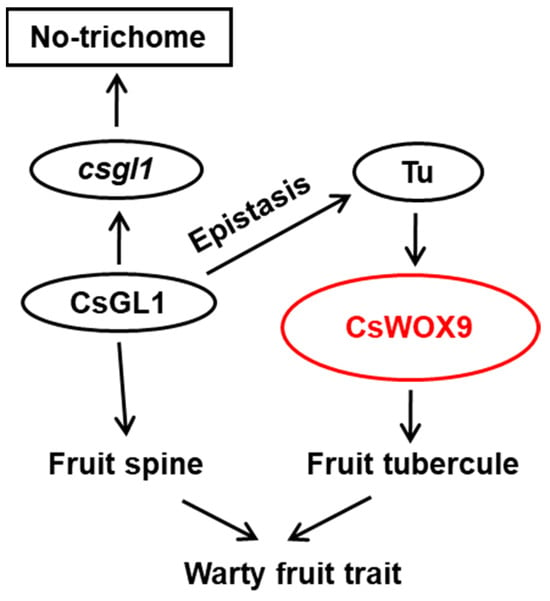
Figure 7.
A proposed genetic network of CsWOX9 involved in regulating the formation of the fruit warts in cucumber. CsGL1 was required for the further differentiation of cucumber trichomes, and the csgl1 mutant exhibited glabrous ovaries/fruits. Furthermore, CsGL1 was essential for Tu expression, as the absence of CsGL1 resulted in the lack of Tu expression and consequently the absence of Tubercules. Thus, csgl1 was epistatic to the Tu gene. The Tu was upregulated before Tubercules’ formation, then activating the expression of CsWOX9 gene transcriptionally, induced the formation of Tubercules.
It was reported that overexpression of CsWOX9, a homolog of AtWOX9, affected the plant architecture and fruit length in Arabidopsis [26]. Tiller growth in rice was dependent on the presence of DWARF TILLER1 (DWT1), which is the homolog of AtWOX8/9 [40]. Additionally, both MtWOX9 and NsWOX9 are orthologs of AtWOX9, and they are necessary for the outgrowth of leaf blade in Medicago truncatula and Nicotiana sylvestris, respectively [41]. EVG, a homolog of AtWOX9 in petunia, is essential for the appropriate branching of the inflorescence apex and plays a role in determining the identity of the floral meristem [42]. The findings indicated that WOX9 TFs, which exhibited structural conservation, played various roles in regulating the development and growth of plants across different species. Through this research, we discovered that CsWOX9 likely plays a role in controlling the formation of fruit warts, suggesting its distinct functionality when compared to homologs in other species.
4. Materials and Methods
4.1. Identification and Phylogenetic Analysis of CsWOX Genes
To identify CsWOX genes in the 12 cucumber genomes (https://www.ncbi.nlm.nih.gov/, accessed on 11 August 2023), the full-length sequences of 15 AtWOX members obtained from the Arabidopsis genome database (https://www.arabidopsis.org, accessed on 11 August 2023) were used for the hidden Markov model (HMM) construction. These varieties included East-Asian lines 9930, XTMC, and Cu2; Eurasian lines Cuc37, Gy14, and 9110gt; Xishuangbanna line Cuc80; and Indian lines Cuc64, W4, W8, Hx14, and Hx117 (Table S1). Subsequently, the HMM file was used for the identification of WOX genes from 12 cucumber genomic databases by HMMER 3.0. The sequences of the candidate members were further analyzed using Pfam (http://pfam.xfam.org, accessed on 12 August 2023) and SMART (http://smart.embl-heidelberg.de, accessed on 12 August 2023) to confirm the existence of the HD.
Alignments of the amino acids sequences of WOX family members from Arabidopsis and cucumber were performed using ClustalW in MEGA 7.0 and used to construct the phylogenetic tree with the neighbor-joining (NJ) method. The tree was visualized and optimized by Evolview (http://www.evolgenius.info/evolview, accessed on 5 October 2023).
4.2. Bioinformatics Analysis of CsWOX Genes
CsWOX TFs, which vary in protein length in at least three different cucumber varieties, were selected for further analyzed. The amino acids sequences of these selected WOX genes from 12 cucumber varieties were obtained based on the pan-genome. The motifs were analyzed using the MEME online program (https://meme-suite.org/meme/tools/meme, accessed on 17 August 2023). The amino acids sequences were aligned using ClustalW in MEGA 7.0 and this alignment was used to generate the phylogenetic tree with the maximum likelihood method. Combination images of phylogenetic clustering, conserved protein motifs and gene structure of CsWOX genes were visualized and optimized using the TBtools software (v2.012; Guangzhou, China).
4.3. Transcriptome Analysis of WOX Genes in Cucumber Ovaries
The expression profiles of the CsWOX genes were analyzed based on published RNA-seq data (SRA046916) [43]. FPKM values were recalculated through clean tags remapping to the cucumber 9930 genome sequence (http://cucurbitgenomics.org/, v3.0, accessed on 25 August 2023) by Biomarker Technologies (Beijing, China). These analyses were performed on cucumber ovaries on different development stages, including unexpanded ovaries, expanded unfertilized ovaries, and expanded fertilized ovaries. There was only one biological replication for each tissue sample. The expression patterns of the CsWOX genes were shown on a heat map using the TBtools software (v2.012; Guangzhou, China).
4.4. Expression Analysis of CsWOX9 by qRT-PCR
Total RNA was extracted using Total RNA Isolation System (Huayueyang, Beijing, China) and used to synthesize cDNA with the EasyScript® One-Step gDNA Removal and cDNA Synthesis SuperMix (TransGen Biotech, Beijing, China). qRT-PCR was performed using the 2X M5 HiPer Realtime PCR Super mix (Mei5 Biotechnology, Beijing, China) with an Applied Biosystems 7500 real-time PCR system. The cucumber UBI (CsaV3_5G031430) gene was used as internal controls. Three biological replicates were used for expression analysis. Primers were listed in Table S2.
4.5. In Situ Hybridization
The unexpanded ovaries (at 7 DBA) were fixed in 3.7% FAA followed with both graded EtOH treatments (50%, 70%, 85%, 95% and 100%, each EtOH concentration for 90 min at 4 °C) and then xylene treatment (50% EtOH/50% xylene for one time, 100% xylene for two times, all treatments at room temperature), embedded with par-aplast after paraplast infiltration for 3 days at 60 °C, sectioned with a microtomes, and hybridized with digoxigenin-labeled sense and antisense gene-specific probe as previous described [44]. The primers with T7 and SP6 RNA polymerase-binding sites were listed in Table S2.
4.6. Subcellular Localization of CsWOX9
The coding region of CsWOX9 without the stop codon was cloned and fused upstream of the GFP sequence between the XbaI and SpeI sites of the pCAMBIA1300 vector, which was modified for this study, to generate 35S::CsWOX9-GFP. The constructs of 35S::CsWOX9-GFP and 35S::GFP were introduced into Agrobacterium strain EHA105 by electroporation, respectively. Agrobacterium cultures carrying 35S:CsWOX9-GFP or 35S::GFP constructs were then infiltrated into tobacco leaves using a needleless syringe. The fluorescence signals were measured at 3 days post infiltration using a Laser Scanning Confocal Microscope 880 (Carl Zeiss AG, Jena, Germany). Primers are listed in Table S2.
4.7. Y1H Assay
The coding sequence of Tu was cloned into the pGADT7 prey vector. Two fragments of CsWOX9 promoter (P1 and P2) containing the C2H2 zinc finger TFs binding sites ACTCA/CAC were shown as the bait sequences. Bait sequences were cloned into the pHis2 vector by using the primers listed in Table S2. The indicated plasmid pairs were transformed into the yeast strain Y187 according to the manufacturer’s instructions (Clontech, Mountain View, CA, USA). The transformed yeast cells carrying an empty pGADT7 vector were used as negative controls. Yeast cells were grown on SD medium lacking Trp and Leu. The transformants were subsequently transferred to SD medium without Trp, Leu, and His, supplemented with 50/100 mM 3-AT. They were cultured for 3–4 days to monitor yeast growth. The experiments were repeated at least three times.
4.8. Dual-LUC Transaction Assay
For study of the binding activity of Tu to the promoter of CsWOX9, the coding sequence of Tu was cloned into the pHB vector at the HindIII and BamHI sites. Simultaneously, the promoter of CsWOX9 (2000 bp) was cloned into the pGreenII 0800-LUC double-reporter vector at the HindIII and BamHI sites [45]. The generated constructs were then transformed into Agrobacterium strain EHA105 and then co-infiltrated into tobacco leaves as above. The firefly LUC activities were measured using vivo imaging system Lumina (Xenogen, Hopkinton, MA, USA).
5. Conclusions
Based on the pan-genome, we identified 11 CsWOX genes. We also observed variations in the protein length and sequence, gene structure, and conserved domains of the same CsWOX genes across different cucumber varieties. Therefore, we hypothesize that CsWOX genes in different cucumber varieties have undergone distinct evolutionary changes to adapt to diverse environmental conditions. CsWOX9 was found to be a fruit-specific expressed gene, particularly in the fruit epidermis. Additionally, the promoter of CsWOX9 interacted with Tu, a requirement for fruit Tubercule formation in cucumber, as confirmed by the Y1H experiment and DLR assay. In this study, a draft model was constructed to demonstrate that CsWOX9 is transcriptionally activated by Tu, resulting in the regulation of fruit wart formation.
Supplementary Materials
The following supporting information can be downloaded at: https://www.mdpi.com/article/10.3390/ijms242417568/s1.
Author Contributions
C.C., Z.R., L.W. and Y.S. conceived and designed the experiments. C.C., S.Y. and L.Z. analyzed the transcriptome data and performed the experiments. C.C., J.L., Y.S. and B.L. wrote and revised the manuscript. C.C. and Z.R. provided fund support. All authors have read and agreed to the published version of the manuscript.
Funding
This research was funded by the National Natural Science Foundation of China (31701923, 32372703, and 32172605), and the Shandong Natural Science Foundation (ZR2022MC084). The funders had no role in study design, data collection, and analysis, data interpretation, or in writing of the manuscript.
Institutional Review Board Statement
Not applicable.
Informed Consent Statement
Not applicable.
Data Availability Statement
Data is contained within the article and supplementary material.
Acknowledgments
We thank Huazhong Ren Lab (China Agricultural University) for providing the modified pCAMBIA1300 vector.
Conflicts of Interest
The authors declare no conflict of interest.
Abbreviations
| Y1H | yeast one-hybrid assay |
| DLR | dual-luciferase reporter |
| WOX | WUSCHEL-related homeobox |
| HD | homeodomain |
| TFs | transcription factors |
| WUS | WUSCHEL |
| RAMs | root apical meristems |
| EVG | EVERGREEN |
| PFS2 | PRETTY FEW SEEDS2 |
| a.a. | amino acids |
| qRT-PCR | quantitative RT-PCR |
| 3-AT | 3-amino-1,2,4-triazole |
| SGR | STAYGREEN |
| DWT1 | DWARF TILLER1 |
| SD | synthetic dextrose |
| DBA | days before anthesis |
References
- Zhang, X.; Zong, J.; Liu, J.; Yin, J.; Zhang, D. Genome-wide analysis of WOX gene family in rice, sorghum, maize, Arabidopsis and poplar. J. Integr. Plant Biol. 2010, 52, 1016–1026. [Google Scholar] [CrossRef] [PubMed]
- Mukherjee, K.; Brocchieri, L.; Burglin, T.R. A comprehensive classification and evolutionary analysis of plant homeobox genes. Mol. Biol. Evol. 2009, 26, 2775–2794. [Google Scholar] [CrossRef] [PubMed]
- Xu, X.Z.; Che, Q.Q.; Cheng, C.X.; Yuan, Y.B.; Wang, Y.Z. Genome-wide identification of WOX gene family in apple and a functional analysis of MdWOX4b during adventitious root formation. J. Integr. Agric. 2022, 21, 1332–1345. [Google Scholar] [CrossRef]
- Hao, Q.N.; Zhang, L.; Yang, Y.Y.; Shan, Z.H.; Zhou, X.A. Genome-Wide Analysis of the WOX Gene Family and Function Exploration of GmWOX18 in Soybean. Plants 2019, 8, 215. [Google Scholar] [CrossRef]
- Haecker, A.; Gross-Hardt, R.; Geiges, B.; Sarkar, A.; Breuninger, H.; Herrmann, M.; Laux, T. Expression dynamics of WOX genes mark cell fate decisions during early embryonic patterning in Arabidopsis thaliana. Development 2004, 131, 657–668. [Google Scholar] [CrossRef]
- Cheng, S.F.; Huang, Y.L.; Zhu, N.; Zhao, Y. The rice WUSCHEL-related homeobox genes are involved in reproductive organ development, hormone signaling and abiotic stress response. Gene 2014, 549, 266–274. [Google Scholar] [CrossRef] [PubMed]
- Gehring, W.J.; Affolter, M.; Burglin, T. Homeodomain proteins. Annu. Rev. Biochem. 1994, 63, 487–526. [Google Scholar] [CrossRef]
- Graaff, E.; Laux, T.; Rensing, S.A. The WUS homeobox-containing (WOX) protein family. Genome Biol. 2009, 10, 248. [Google Scholar]
- Costanzo, E.; Trehin, C.; Vandenbussche, M. The role of WOX genes in flower development. Ann. Bot. 2014, 114, 1545–1553. [Google Scholar] [CrossRef]
- Deveaux, Y.; Toffano-Nioche, C.; Claisse, G.; Thareau, V.; Morin, H.; Laufs, P.; Moreau, H.; Kreis, M.; Lecharny, A. Genes of the most conserved WOX clade in plants affect root and flower development in Arabidopsis. BMC Evol. Biol. 2008, 8, 291. [Google Scholar] [CrossRef]
- Rathour, M.; Sharma, A.; Kaur, A.; Upadhyay, S.K. Genome-wide characterization and expression and co-expression analysis suggested diverse functions of WOX genes in bread wheat. Heliyon 2020, 6, e05762. [Google Scholar] [CrossRef] [PubMed]
- Mayer, K.F.; Schoof, H.; Haecker, A.; Lenhard, M.; Jurgens, G.; Laux, T. Role of WUSCHEL in regulating stem cell fate in the Arabidopsis shoot meristem. Cell 1998, 95, 805–815. [Google Scholar] [CrossRef]
- Schoof, H.; Lenhard, M.; Haecker, A.; Mayer, K.F.X.; Jürgens, G.; Laux, T. The stem cell population of Arabidopsis shoot meristems in maintained by a regulatory loop between the CLAVATA and WUSCHEL genes. Cell 2000, 100, 635–644. [Google Scholar] [CrossRef] [PubMed]
- Sarkar, A.K.; Luijten, M.; Miyashima, S.; Lenhard, M.; Hashimoto, T.; Nakajima, K.; Scheres, B.; Heidstra, R.; Laux, T. Conserved factors regulate signalling in Arabidopsis thaliana shoot and root stem cell organizers. Nature 2007, 446, 811–814. [Google Scholar] [CrossRef] [PubMed]
- Hirakawa, Y.; Kondo, Y.; Fukuda, H. TDIF peptide signaling regulates vascular stem cell proliferation via the WOX4 homeobox gene in Arabidopsis. Plant Cell 2010, 22, 2618–2629. [Google Scholar] [CrossRef]
- Pi, L.M.; Aichinger, E.; van der Graaff, E.; Llavata-Peris, C.I.; Weijers, D.; Hennig, L.; Groot, E.; Laux, T. Organizer-Derived WOX5 Signal Maintains Root Columella Stem Cells through Chromatin-Mediated Repression of CDF4 Expression. Dev. Cell 2015, 33, 576–588. [Google Scholar] [CrossRef]
- Osipova, M.A.; Mortier, V.; Demchenko, K.N.; Tsyganov, V.E.; Tikhonovich, I.A.; Lutova, L.A.; Dolgikh, E.A.; Goormachtig, S. Wuschel-related homeobox5 gene expression and interaction of CLE peptides with components of the systemic control add two pieces to the puzzle of autoregulation of nodulation. Plant Physiol. 2012, 158, 1329–1341. [Google Scholar] [CrossRef]
- Zhou, S.L.; Jiang, W.; Long, F.; Cheng, S.F.; Yang, W.J.; Zhao, Y.; Zhou, D.X. Rice Homeodomain Protein WOX11 Recruits a Histone Acetyltransferase Complex to Establish Programs of Cell Proliferation of Crown Root Meristem. Plant Cell 2017, 29, 1088–1104. [Google Scholar] [CrossRef]
- Kong, D.; Hao, Y.; Cui, H. The WUSCHEL Related Homeobox Protein WOX7 Regulates the Sugar Response of Lateral Root Development in Arabidopsis thaliana. Mol. Plant 2016, 9, 261–270. [Google Scholar] [CrossRef]
- Chen, R.; Xu, N.; Yu, B.; Wu, Q.; Li, X.; Wang, G.; Huang, J. The WUSCHEL-related homeobox transcription factor OsWOX4 controls the primary root elongation by activating OsAUX1 in rice. Plant Sci. 2020, 298, 110575. [Google Scholar] [CrossRef]
- Li, J.B.; Jia, H.X.; Sun, P.; Zhang, J.; Xia, Y.X.; Hu, J.J.; Wang, L.J.; Lu, M.Z. The WUSCHELa (PtoWUSa) is involved in developmental plasticity of adventitious root in poplar. Genes 2020, 11, 176. [Google Scholar] [CrossRef] [PubMed]
- Li, J.B.; Zhang, J.; Jia, H.X.; Liu, B.B.; Sun, P.; Hu, J.J.; Wang, L.J.; Lu, M.Z. The WUSCHEL-related homeobox 5a(PtoWOX5a) is involved in adventitious root development in poplar. Tree Physiol. 2018, 38, 139–153. [Google Scholar] [CrossRef]
- Zhang, C.; Wang, J.; Wang, X.; Li, C.; Ye, Z.; Zhang, J. UF, a WOX gene, regulates a novel phenotype of un-fused flower in tomato. Plant Sci. 2020, 297, 110523. [Google Scholar] [CrossRef] [PubMed]
- Park, S.O. The PRETTY FEW SEEDS2 gene encodes an Arabidopsis homeodomain protein that regulates ovule development. Development 2005, 132, 841–849. [Google Scholar] [CrossRef]
- Park, S.O.; Hwang, S.; Hauser, B.A. The phenotype of Arabidopsis ovule mutants mimics the morphology of primitive seed plants. Proc. Biol. Sci. 2004, 271, 311–316. [Google Scholar] [CrossRef] [PubMed]
- Gu, R.; Song, X.; Liu, X.; Yan, L.; Zhang, X. Genome-wide analysis of CsWOX transcription factor gene family in cucumber (Cucumis sativus L.). Sci. Rep. 2020, 10, 6216. [Google Scholar] [CrossRef]
- Yang, X.; Zhang, W.; He, H.; Nie, J.; Bie, B.; Zhao, J.; Ren, G.; Li, Y.; Zhang, D.; Pan, J.; et al. Tuberculate fruit gene Tu encodes a C2H2 zinc finger protein that is required for the warty fruit phenotype in cucumber (Cucumis sativus L.). Plant J. 2014, 78, 1034–1046. [Google Scholar] [CrossRef]
- Che, G.; Zhang, X. Molecular basis of cucumber fruit domestication. Curr. Opin. Plant Biol. 2019, 47, 38–46. [Google Scholar] [CrossRef]
- Han, N.; Tang, R.; Chen, X.; Xu, Z.; Ren, Z.; Wang, L. Genome-wide identification and characterization of WOX genes in Cucumis sativus. Genome 2021, 64, 761–776. [Google Scholar] [CrossRef]
- Bayer, P.E.; Golicz, A.A.; Scheben, A.; Batley, J.; Edwards, D. Plant pan-genomes are the new reference. Nat. Plants 2020, 6, 914–920. [Google Scholar] [CrossRef]
- Li, R.; Li, Y.; Zheng, H.; Luo, R.; Zhu, H.; Li, Q.; Qian, W.; Ren, Y.; Tian, G.; Li, J.; et al. Building the sequence map of the human pan-genome. Nat. Biotechnol. 2010, 28, 57–63. [Google Scholar] [CrossRef] [PubMed]
- Gao, L.; Gonda, I.; Sun, H.H.; Ma, Q.Y.; Bao, K.; Tieman, D.M.; Burzynski-Chang, E.A.; Fish, T.L.; Stromberg, K.A.; Sacks, G.L.; et al. The tomato pan-genome uncovers new genes and a rare allele regulating fruit flavor. Nat. Genet. 2019, 51, 1044–1051. [Google Scholar] [CrossRef] [PubMed]
- Tao, Y.F.; Luo, H.; Xu, J.B.; Cruickshank, A.; Zhao, X.R.; Teng, F.; Hathorn, A.; Wu, X.Y.; Liu, Y.M.; Shatte, T.; et al. Extensive variation within the pan-genome of cultivated and wild sorghum. Nat. Plants 2021, 7, 766–773. [Google Scholar] [CrossRef] [PubMed]
- Tettelin, H.; Masignani, V.; Cieslewicz, M.J.; Donati, C.; Medini, D.; Ward, N.L.; Angiuoli, S.V.; Crabtree, J.; Jones, A.L.; Durkin, A.S.; et al. Genome analysis of multiple pathogenic isolates of Streptococcus agalactiae: Implications for the microbial “pan-genome”. Proc. Natl. Acad. Sci. USA 2005, 102, 13950–13955. [Google Scholar] [CrossRef] [PubMed]
- Li, H.; Wang, S.; Chai, S.; Yang, Z.; Zhang, Z. Graph-based pan-genome reveals structural and sequence variations related to agronomic traits and domestication in cucumber. Nat. Commun. 2022, 13, 682. [Google Scholar] [CrossRef] [PubMed]
- Hu, R.; Qi, G.; Kong, Y.; Kong, D.; Gao, Q.; Zhou, G. Comprehensive analysis of NAC domain transcription factor gene family in Populus trichocarpa. BMC Plant Biol. 2010, 10, 145. [Google Scholar] [CrossRef] [PubMed]
- Wang, Y.; Tan, J.; Wu, Z.; VandenLangenberg, K.; Wehner, T.; Wen, C.; Zheng, X.; Owens, K.; Thornton, A.; Bang, H.; et al. STAYGREEN, STAY HEALTHY: A loss-of-susceptibility mutation in the STAYGREEN gene provides durable, broad-spectrum disease resistances for over 50 years of US cucumber production. New Phytol. 2019, 221, 415–430. [Google Scholar] [CrossRef]
- Sun, L.; Zhang, A.; Zhou, Z.; Zhao, Y.; Yan, A.; Bao, S.; Yu, H.; Gan, Y. GLABROUS INFLORESCENCE STEMS3 (GIS3) regulates trichome initiation and development in Arabidopsis. New Phytol. 2015, 206, 220–230. [Google Scholar] [CrossRef]
- Li, Q.; Cao, C.X.; Zhang, C.J.; Zheng, S.S.; Wang, Z.H.; Wang, L.N.; Ren, Z.H. The identification of Cucumis sativus Glabrous 1 (CsGL1) required for the formation of trichomes uncovers a novel function for the homeodomain-leucine zipper I gene. J. Exp. Bot. 2015, 66, 2515–2526. [Google Scholar] [CrossRef]
- Wang, W.F.; Li, G.; Zhao, J.; Chu, H.W.; Lin, W.H.; Zhang, D.B.; Wang, Z.Y.; Liang, W.Q. DWARF TILLER1, a WUSCHEL-Related Homeobox Transcription Factor, Is Required for Tiller Growth in Rice. PLoS Genet. 2014, 10, e1004154. [Google Scholar] [CrossRef]
- Wolabu, T.W.; Wang, H.; Tadesse, D.; Zhang, F.; Behzadirad, M.; Tvorogova, V.E.; Abdelmageed, H.; Liu, Y.; Chen, N.; Chen, J.; et al. WOX9 functions antagonistic to STF and LAM1 to regulate leaf blade expansion in Medicago truncatula and Nicotiana sylvestris. New Phytol. 2021, 229, 1582–1597. [Google Scholar] [CrossRef] [PubMed]
- Rebocho, A.B.; Bliek, M.; Kusters, E.; Castel, R.; Procissi, A.; Roobeek, I.; Souer, E.; Koes, R. Role of EVERGREEN in the development of the cymose petunia inflorescence. Dev. Cell 2008, 15, 437–447. [Google Scholar] [CrossRef] [PubMed]
- Li, Z.; Zhang, Z.; Yan, P.; Huang, S.; Fei, Z.; Lin, K. RNA-Seq improves annotation of protein-coding genes in the cucumber genome. BMC Genom. 2011, 12, 540. [Google Scholar] [CrossRef] [PubMed]
- Zhang, X.; Zhou, Y.; Ding, L.; Wu, Z.; Liu, R.; Meyerowitz, E.M. Transcription repressor HANABA TARANU controls flower development by integrating the actions of multiple hormones, floral organ specification genes, and GATA3 family genes in Arabidopsis. Plant Cell 2013, 25, 83–101. [Google Scholar] [CrossRef]
- Hellens, R.P.; Allan, A.C.; Friel, E.N.; Bolitho, K.; Grafton, K.; Templeton, M.D.; Karunairetnam, S.; Gleave, A.P.; Laing, W.A. Transient expression vectors for functional genomics, quantification of promoter activity and RNA silencing in plants. Plant Methods 2005, 1, 13. [Google Scholar] [CrossRef]
Disclaimer/Publisher’s Note: The statements, opinions and data contained in all publications are solely those of the individual author(s) and contributor(s) and not of MDPI and/or the editor(s). MDPI and/or the editor(s) disclaim responsibility for any injury to people or property resulting from any ideas, methods, instructions or products referred to in the content. |
© 2023 by the authors. Licensee MDPI, Basel, Switzerland. This article is an open access article distributed under the terms and conditions of the Creative Commons Attribution (CC BY) license (https://creativecommons.org/licenses/by/4.0/).